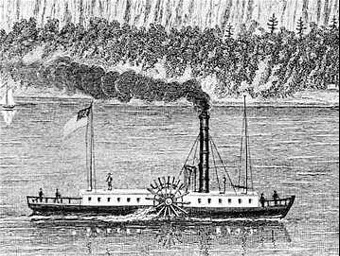The Revolutionary Impact of the Marine Propeller
Frédéric Sauvage, a pioneer of naval engineering, played a fundamental role in revolutionizing naval propulsion with his invention of the marine spiral propeller. His innovation laid the groundwork for contemporary marine motorization but, tragically, he never enjoyed the recognition or benefits of his remarkable contribution.
A Departure from Conventional Paddlewheel Methods
In the early 1830s, when the paddlewheel reigned supreme on European steamships, Sauvage envisioned a more effective propulsion system. His design, inspired by the natural movements of fish, was first publicly demonstrated in January 1832 in Boulogne. Even as he showcased a model weighing less than a kilogram that achieved speeds three times faster than traditional paddlewheels, the Ministry of the Navy dismissed the propeller as impractical for larger ships. The refusal was fortified by experiments in the United States, which claimed that the propeller struggled to pull larger vessels, an assertion that stalled broader acceptance.
A Visionary Caught Out of Time
In 1833, Sauvage shifted to a more hands-on approach as he journeyed down the Seine in his experimental canoe. Lacking a steam engine, he relied on human-powered mechanisms to rotate the propeller. Unfortunately, a dearth of funds forced him into debt and compulsion to seek assistance from his brother in Abbeville. His attempts to construct a boat in Honfleur fell short due to financial constraints. Back in Paris, following a brief success with another creation, the physionotype, he became embroiled in legal disputes that detracted from his naval aspirations. Despite extending his patent for aerial applications in 1839, he still faced skepticism from technical authorities.
The Archimede and Claims of Intellectual Theft
By 1838, the British steamer Archimede had adopted a propulsion design closely resembling Sauvage’s, showcasing its potential. Launched in May 1839, the vessel demonstrated impressive speed of 8.5 knots at sea, prompting Sauvage to declare that his invention was misappropriated abroad, and he remained uncompensated.
The subsequent year brought a bittersweet development as he signed a contract with a shipbuilder to design a mail steamer, the Napoleon, which achieved success with an average speed of 10 knots. While he held the patent, his lack of involvement in the design meant he could not claim credit for the ship’s accolades, leading to protests but no change in his contractual obligations.
Decline into Isolation and Madness
The struggles continued for Sauvage when, in May 1843, he was imprisoned in Le Havre after being taken to court by his creditors. He remained incarcerated for several months until released, thanks to public advocacy from Alphonse Karr, a journalist. Despite receiving a small pension, he was in a state of ruin, financially and mentally drained. By April 1854, his mental well-being led to his commitment to a nursing home in Paris, where he ultimately passed away in July 1857 at the age of 56. His remains were moved to Boulogne-sur-Mer fifteen years later, preserving his legacy in the eastern cemetery.
A Lasting Legacy in Marine Propulsion
Today, the marine propeller stands as a standard in marine propulsion, a concept that remains fundamentally unchanged since Sauvage’s inventive work. Despite the vital nature of his contributions, he received little acknowledgment during his life, stark contrast to the widespread use of his invention in modern times.
Fun Facts about Marine Propellers
- Material Evolution: Early propellers were crafted from wood, while modern ones are often made from advanced composites or metals for improved durability.
- Propeller Efficiency: The shape and design of a propeller greatly influence its efficiency, impacting speed and fuel consumption.
- Maritime Applications: Propellers are not restricted to boats; they are integral to submarines and many marine systems requiring propulsion.
- History of Innovation: John Ericsson, a contemporary of Sauvage, also made significant strides in the development of the screw propeller, affirming the era’s innovative spirit.
GetBoat consistently monitors maritime innovations and developments relevant to sailing and coastal leisure. The freedom and adventure that sailing offers allow individuals to explore new horizons and experience the ocean’s beauty firsthand. GetBoat values the energy of sailing and offers a platform where clients can choose vessels tailored to their preferences, budget, and taste. With various options available, clients can find unique opportunities for quality time with friends, family, or themselves on the water, ensuring a memorable adventure at sea.
The Multifaceted Experience of New Coastal Destinations
As you consider your next seaside adventure, remember that each new location is a tapestry of cultural, natural, and culinary richness. A boat rental allows intimate exploration of hidden inlets, pristine beaches, and picturesque lagoons, often reserved for those at the helm of their own vessel. The journey by boat can be just as enlightening as exploring local cuisine or architecture.
GetBoat.com makes it easy for you to dive into these experiences through a boat rental.Future of Marine Travel
The innovations in marine propulsion not only reshape the way vessels operate but also redefine travel experiences in the maritime world. As propeller technology continues evolving, it’s essential to stay informed and updated on industry changes that will impact boating opportunities globally. Gaining insights into these developments can guide your next nautical adventure. Join the community of boat lovers as you explore and discover sailing and boat rental options that will take you to new water environments and help you embrace the open sea.


